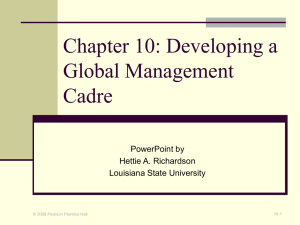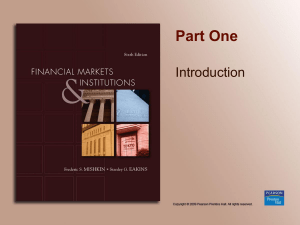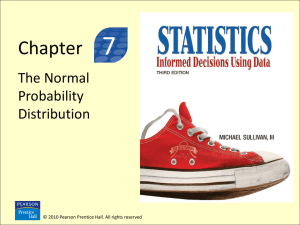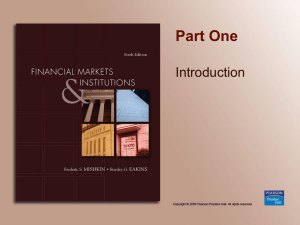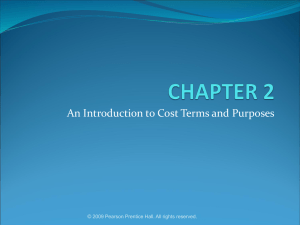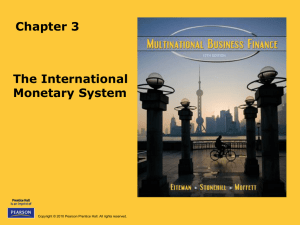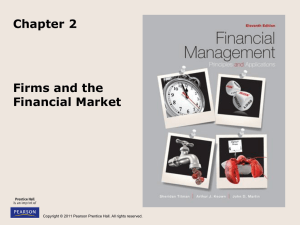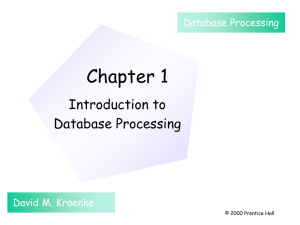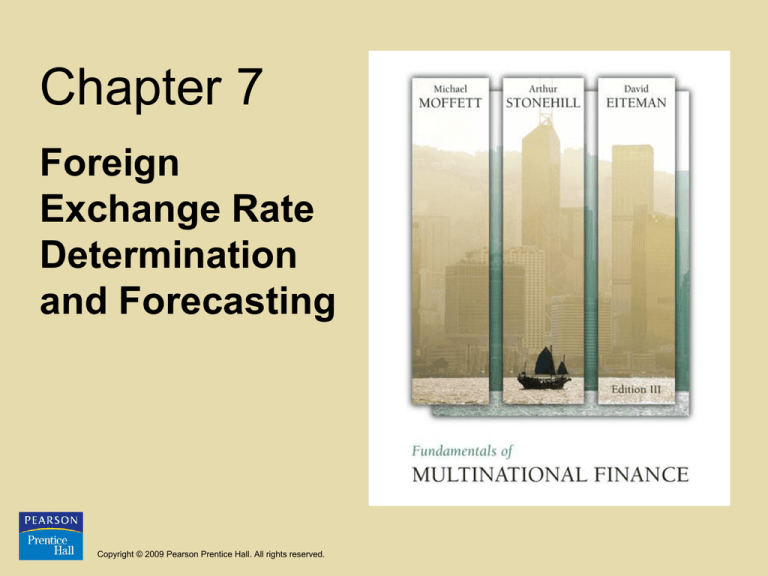
Chapter 7
Foreign
Exchange Rate
Determination
and Forecasting
Copyright © 2009 Pearson Prentice Hall. All rights reserved.
Exchange Rate Determination:
Learning Objectives
• Examine how the supply and demand for any currency can
be viewed as an asset choice issue within the portfolio of
investors
• Explore how the three major approaches to exchange rate
determination – parity conditions, the balance of payments,
and the asset approach – combine to explain in part the
recent currency crises experienced in Asia and Argentina
• Observe how forecasters combine technical analysis with
the three major theoretical approaches to forecasting
exchange rates
Copyright © 2009 Pearson Prentice Hall. All rights reserved.
7-2
Exchange Rate Determination
• Three basic approaches
– Parity conditions
– Balance of Payments
– Asset market
• These are not competing theories but are in fact
complimentary theories
• Without the depth and breadth of the various
approaches combined, our ability to capture the
complexity of the global market for currencies is lost
Copyright © 2009 Pearson Prentice Hall. All rights reserved.
7-3
Exchange Rate Determination
• Along with an understanding of the theories, an
understanding of the complexities of international political
economy, societal and economic infrastructures, and
random political and social events is needed when viewing
the foreign exchange markets
– Infrastructure weaknesses were among the major causes of the exchange
rate collapses in emerging markets in the late 1990s
– Speculation contributed greatly to the emerging market crises.
Uncovered interest rate arbitrage caused by extremely low interest rates in
Japan coupled with high real interest rates in the US was a problem in the
1990s
Copyright © 2009 Pearson Prentice Hall. All rights reserved.
7-4
Exchange Rate Determination
– Cross-border foreign direct investment and international
portfolio investment into emerging markets dried up during
the recent crises
– Foreign political risks have been much reduced in recent
years as capital markets became less segmented from each
other and more liquid
– Finally, note that most determinants of spot exchange rates
are also in turn affected by changes in the spot rate – in other
words, they are not only linked but mutually determined
Copyright © 2009 Pearson Prentice Hall. All rights reserved.
7-5
Exhibit 7.1 The Determinants of
Foreign Exchange Rates
Copyright © 2009 Pearson Prentice Hall. All rights reserved.
7-6
Purchasing Power Parity Approach
• PPP is the oldest and most widely followed of
the exchange rate theories
• PPP is embedded within most theories of
exchange rate determination
• PPP calculations and forecasts have structural
differences across countries and significant data
challenges in estimation
Copyright © 2009 Pearson Prentice Hall. All rights reserved.
7-7
Balance of Payments (Flows)
Approach
• Essentially BOP approach says equilibrium exchange
rate is achieved when current account inflows match
current account outflows
• BOP transactions are widely appealing, captured, and
reported
• Criticism of the BOP approach is that it focuses on
flows rather than stocks of money or financial assets
• Relative stocks of money or financial assets do not play
a role in the theory
• Practitioners use BOP but academics largely dismiss it
Copyright © 2009 Pearson Prentice Hall. All rights reserved.
7-8
Monetary Approaches
• Changes in supply and demand for money largely determine
inflation which in turn alter exchange rates
• Prices are flexible in both the short and long-run thus, the
transmission impact is immediate
• Real economic activity influences exchange rates through
any alterations in demand for money
• Omits a number of important factors for exchange rate
determination including:
– The failure of PPP to hold in the short to medium term
– Money demand appears to be relatively unstable over time
– The level of economic activity and the money supply do not appear
to be independent
• Do to these significant omissions the authors choose to
ignore this approach
Copyright © 2009 Pearson Prentice Hall. All rights reserved.
7-9
Asset Market Approach
• AKA relative price of bonds or portfolio balance
approach
• argues that exchange rates are determined by supply
and demand for a wide variety of assets
– Shifts in supply and demand alter exchange rates
– Changes in monetary and fiscal policy alter expectations and
thus exchange rates
– Theories of currency substitution follow the same basis
premises of portfolio rebalance framework
Copyright © 2009 Pearson Prentice Hall. All rights reserved.
7-10
Asset Market Approach
• The Asset market approach assumes that whether
foreigners are willing to hold claims in monetary form
depends on an extensive set of investment
considerations or drivers (as per the previous exhibit)
• In highly developed countries, foreign investors are
willing to hold securities and undertake foreign direct
investment based primarily on relative real interest rates
and the outlook for economic growth and profitability
Copyright © 2009 Pearson Prentice Hall. All rights reserved.
7-11
Disequilibria: Exchange Rates in
Emerging Markets
• Although the three different schools of thought on exchange
rate determination make understanding exchange rates
appear to be straightforward, that is rarely the case
• The problem lies not in the theories but in the relevance of
the assumptions underlying each theory
• After several years of relative global economic tranquility,
the second half of the 1990s was racked by a series of
currency crises which shook all emerging markets
– The Asian crisis of July 1997
– The Argentine crisis (1998 – 2002)
Copyright © 2009 Pearson Prentice Hall. All rights reserved.
7-12
The Asian Crisis – July 1997
• The roots of the Asian crisis extended from a
fundamental change in the economies of the region, the
transition of many Asian countries from being net
exporters to net importers
• Starting in 1990 in Thailand, the rapidly expanding
economies of the Far East began importing more than
they were exporting, requiring major net capital inflows
to support their currencies
– As long as capital kept flowing in, the currencies were stable,
but if this inflow stopped then the governments would not be
able to support their fixed currencies
Copyright © 2009 Pearson Prentice Hall. All rights reserved.
7-13
The Asian Crisis – July 1997
• The most visible roots of the crisis were in the excesses
of capital inflows into Thailand in 1996 and 1997
• Thai banks, firms and finance companies had ready
access to capital and found US dollar denominated debt
at cheap rates
• Banks continued to extend credits and as long as the
capital inflows were still coming, the banks, firms, and
government was able to support these credit extensions
abroad
Copyright © 2009 Pearson Prentice Hall. All rights reserved.
7-14
The Asian Crisis – July 1997
• After some time, the Thai Baht came under attack due to the
country’s rising debt
• The Thai government intervened in the foreign exchange
markets directly to try to defend the Baht by selling foreign
reserves and indirectly by raising interest rates
• This caused the Thai markets to come to a halt along with
massive currency losses and bank failures
• On July 2, 1997 the Thai central bank allowed the Baht to
float and it fell over 17% against the dollar and 12% against
the Japanese Yen
– By November 1997, the baht fell 38% against the US dollar
Copyright © 2009 Pearson Prentice Hall. All rights reserved.
7-15
The Asian Crisis – July 1997
• Within days, other Asian countries suffered from the
contagion effect from Thailand’s devaluation
• Speculators and capital markets turned towards countries
with similar economic traits as Thailand and their
currencies fell under attack
• In late October, Taiwan caught the markets off-guard with a
15% devaluation and this only added to the momentum
– The Korean Won fell from WON900/$ to WON1100/$ (18.2%)
– The Malaysian ringgit fell 28.6% and the Filipino peso fell 20.6%
against the dollar
• The only currencies that were not severely affected were the
Hong Kong dollar and the Chinese renminbi
Copyright © 2009 Pearson Prentice Hall. All rights reserved.
7-16
Exhibit 7.2 The Economies and
Currencies of Asia, July-November 1997
Copyright © 2009 Pearson Prentice Hall. All rights reserved.
7-17
Exhibit 7.3 Comparative Daily
Exchange Rates: Relative to U.S. Dollar
Copyright © 2009 Pearson Prentice Hall. All rights reserved.
7-18
The Asian Crisis – July 1997
• The Asian currency crisis was more than just a currency
collapse
• Although the varying countries were different they did
have similar characteristics which allow comparison
– Corporate socialism – Post WWII Asian companies believed
that their governments would not allow them to fail, thus they
engaged in practices, such as lifetime employment, that were
no longer sustainable
Copyright © 2009 Pearson Prentice Hall. All rights reserved.
7-19
The Asian Crisis – July 1997
– Corporate governance – Most companies in the Far East
were often largely controlled by either families or groups
related to the governing body or party of that country
• This was labeled cronyism and allowed the management to ignore the
bottom line at times when this was deteriorating
– Banking liquidity and management – Although bank
regulatory structures and markets have been deregulated
across the globe, their central role in the conduct of business
has been ignored
• As firms collapsed, government coffers were emptied and investments
made by banks failed
• The banks became illiquid and they could no longer support
companies’ need for capital
Copyright © 2009 Pearson Prentice Hall. All rights reserved.
7-20
The Argentine Crisis - 2002
• In 1991 the Argentine peso had been fixed to the U.S.
dollar at a one-to-one rate of exchange
• This policy was a radical departure from traditional
methods of fixing the rate of a currency’s value
• Argentina adopted a currency board, which was a
structure rather than just a commitment, to limiting the
growth of money in the economy
• Under a currency board, the central bank of a country
may increase the money supply in the banking system
only with increases in its holdings of hard currency
reserves
Copyright © 2009 Pearson Prentice Hall. All rights reserved.
7-21
The Argentine Crisis - 2002
• By removing the ability of government to expand the
rate of growth of the money supply, Argentina believed
it was eliminating the source of inflation which had
devastated its standard of living
• The idea was to limit the rate of growth in the country’s
money supply to the rate at which the country receives
net inflows of U.S. dollars as a result of trade growth
and general surplus
Copyright © 2009 Pearson Prentice Hall. All rights reserved.
7-22
Exhibit 7.4 Argentina’s Economic
Performance, 1991-2000
Copyright © 2009 Pearson Prentice Hall. All rights reserved.
7-23
The Argentine Crisis - 2002
• A recession that began in 1998, as a result of a
restrictive monetary policy, continued to worsen by
2001 and revealed three very important problems with
Argentina’s economy:
– The Argentine peso was overvalued
– The currency board regime had eliminated monetary policy
alternatives for macroeconomic policy
– The Argentine government budget deficit – and deficit
spending – was out of control
Copyright © 2009 Pearson Prentice Hall. All rights reserved.
7-24
The Argentine Crisis - 2002
• While the value of the peso had been stabilized,
inflation had not been eliminated
• The inability of the peso’s value to change with market
forces led many to believe increasingly that it was
overvalued
• Argentine exports became some of the most expensive
in all of South America as other countries saw their
currencies slide marginally against the dollar over the
past decade while the peso did not
Copyright © 2009 Pearson Prentice Hall. All rights reserved.
7-25
The Argentine Crisis - 2002
• Because the currency board eliminated expansionary
monetary policy as a means to stimulate economic
growth in Argentina, the Argentine government was left
with only fiscal policy as a means to this end
• The Argentine government continued to spend as a
means to quell increasing social and political tensions
and unrest, but without the benefit of increasing (or
even stable) tax receipts
• Continued government spending and the injection of
foreign capital into the country steadily increased the
debt burden
Copyright © 2009 Pearson Prentice Hall. All rights reserved.
7-26
Exhibit 7.5 Argentina’s Debt and
Key Balances, 1991-2000
Copyright © 2009 Pearson Prentice Hall. All rights reserved.
7-27
The Argentine Crisis - 2002
• Many began to fear an impending devaluation, removing
their peso denominated funds (as well as U.S. dollar funds)
from Argentine banks
• Capital flight as well as rampant conversion of peso
holdings into U.S. dollar deposits put additional pressure on
the value of the peso
• On Sunday January 6, 2002, in the first act of his
presidency (the fifth president in two weeks), President
Eduardo Duhalde devalued the peso from Ps 1.00/$ to Ps
1.40/$
• On February 3, 2002, the government announced that the
peso would be floated, beginning a slow but gradual
depreciation
7-28
Copyright © 2009 Pearson Prentice Hall. All rights reserved.
Exhibit 7.6 Daily Exchange Rates:
Argentine Pesos per U.S. Dollar
Copyright © 2009 Pearson Prentice Hall. All rights reserved.
7-29
Exhibit 7.7 A Timeline of Events in
the Argentine Crisis
Copyright © 2009 Pearson Prentice Hall. All rights reserved.
7-30
Forecasting in Practice
• In addition to the three approaches to forecasting discussed
earlier (Parity Conditions, Balance of Payments, Asset
Approach) forecasting practitioners also utilize technical
analysis
• These analysts, traditionally referred to as chartists, focus
on price and volume data to determine past trends that are
expected to continue into the future
• The longer time horizon of the forecast, the more inaccurate
the forecast is likely to be
• The following summarizes the various forecasting periods,
regimes and preferred forecasting methods for each
Copyright © 2009 Pearson Prentice Hall. All rights reserved.
7-31
Exhibit 7.8 Exchange Rate Forecasting
in Practice
Copyright © 2009 Pearson Prentice Hall. All rights reserved.
7-32
Forecasting in Practice
• Decades of theoretical and empirical studies show that
exchange rates do adhere to the fundamental principles
and theories outlined in the previous sections –
fundamentals do apply in the long term
• Therefore, there is something of a fundamental
equilibrium path for a currency’s value
• In the short term, a variety of random events,
institutional frictions, and technical factors may cause
currency values to deviate significantly from their long
term fundamental path – this is sometimes referred to as
noise
Copyright © 2009 Pearson Prentice Hall. All rights reserved.
7-33
Exhibit 7.9 Differentiating Short-Term
Noise From Long-Term Trends
Copyright © 2009 Pearson Prentice Hall. All rights reserved.
7-34
Forecasting in Practice
• Although the various theories surrounding exchange
rate determination are clear and sound, it may appear
on a day-to-day basis that the currency markets do not
pay much attention to the theories
• The difficulty is understanding which fundamentals are
driving markets at which points in time
• One example of this relative confusion over exchange
rate dynamics is the phenomenon known as
overshooting
Copyright © 2009 Pearson Prentice Hall. All rights reserved.
7-35
Exhibit 7.10 Exchange Rate Dynamics:
Overshooting
Copyright © 2009 Pearson Prentice Hall. All rights reserved.
7-36
Summary of Learning Objectives
• The asset approach suggests that whether foreigners are
willing to hold claims in monetary form depends partly
on relative real interest rates and partly on a country’s
outlook for economic growth
• Longer-term forecasting requires a return to basic
analysis of exchange rate fundamentals such as BOP,
relative inflation, interest rates and long-run properties
of PPP
• Technical analysis focus on price and volume data to
determine past trends that are expected to continue in
the future
Copyright © 2009 Pearson Prentice Hall. All rights reserved.
7-37
Summary of Learning Objectives
• Exchange rate forecasting in practice is a mix of both
fundamental and technical forms of analysis
• The Asian crisis was primarily a BOP crisis in its origins and
impacts on exchange rates. A weak economic and financial
infrastructure, corporate governance problems and speculation
also contributed
• The Argentina crisis of 2002 was probably a combination of
disequilibrium in international parity conditions (different rates
of inflation) and balance of payments disequilibrium (current
account deficits combined with financial account outflows)
Copyright © 2009 Pearson Prentice Hall. All rights reserved.
7-38

